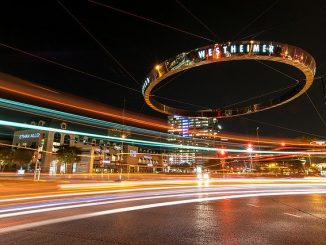
Last week, a citizen complained to me that it was difficult for him to get to a city office by using the bus. The recent changes in service had moved the only bus route serving the area over by one major street, resulting in a lengthy walk for an elderly man like himself, who had breathing problems. That bothered me, a lot. After all, bus service and other mass transit is most commonly used for social engineering, enhancing property values and developers’ profits getting people from point A to point B, because they can’t afford a car or can’t drive, but still need to travel around the city. This means college students, the elderly, and the poor. If the service can’t get these people to where they need to go, what good is it?
With that in mind, I started reviewing the distances from the nearest bus stop to various sites that might be visited by people without a car. The results were interesting. For those of us who have forgotten the details, a mile is 5,280 feet, so a tenth of a mile is 528 feet. It doesn’t sound bad to say that a stop is a tenth of a mile away, since that’s only a little over 500 feet. But it’s a distance that may be walked by elderly or infirm people, in the case of the clinics and Multi-Service Centers listed below, and certain city offices. It seems odd that in many cases, the nearest stop is located some distance away from what would be the most logical stopping point for bus riders.
Head below the fold for the results of this entirely unscientific review of Metro’s “convenience factor.”
Starting point for all trips was City Hall, 900 Bagby.
| Acres Home Health Clinic | .36 mi. |
| Casa de Amigos Health Clinic | .15 mi. |
| Fifth Ward Multi-Service Center | .11 mi. |
| COH Health Clinic | .15 mi. |
| Gulf Coast Community Services –North Point Station –Southwest Station |
.27 mi. .12 mi. |
| Houston Hospice | No Service |
| Houston Museum of Natural Science | .14 mi. |
| Houston Public Library –Clayton Library –Freed-Montrose Branch –Parent Resource Library –Smith Branch |
.23 mi. .11 mi. .22 mi. .15 mi. |
| Houston Zoo | .24 mi. |
| Lyons Clinic | .11 mi. |
| Magnolia Multi Service Center | .10 mi. |
| People’s Health Center | .18 mi. |
| Sunnyside Multi-Service Center | .17 mi. |
| Utility Customer Service Center | .23 mi. |
Distances for all stops are determined by using the “Walking Distance” as reported by METRO’s Trip Planner. Some of them could be put down to traffic and road design forcing the bus stops to be located in inconvenient spots, but the 1/4 mile to the Parent Resource Library is particularly disappointing, as it is located in the Children’s Museum. The Zoo also scores poorly — not that it’s very affordable since the Zoo Development Corporation took over and raised the rates about 300% in four years. The Utility Customer Service Center (a.k.a. the Water Department) is also a surprise, with the nearest route now being on Polk street!
“No Service” as listed for the Houston Hospice means, according to Metro:
- Your request is for times during the day when service is not provided in that area.
- Your requested origin and/or destination are not within 0.5 miles of the closest transit stop.
- Your request will require an unreasonable number of transfers or a duration of longer than three hours.
As a commentor over at the Sit n’ Spin Blog says:
And then there is all the checking bus schedules–maybe I should try the old #30 on the new #30 route and transfer to the #42 nearer campus. Why, if it’s not raining, cold or windy, or incredibly hot I could walk those blocks. It would be good exercise. Should I move? Should I learn how to drive? Should I get out of Houston? Maybe I should run for the transit board. Why does a major city transportation system force its passengers to consider all the alternatives to riding its system because it has chosen to streamline its services so much that it no longer provides them? Why, Houston, are we putting up with this? If we are going to be a major metropolitan community, we need public transportation and we need one that works for the people, not the planners.
Indeed. You know, if you could “run for the transit board” maybe the services would be a little more convenient.
OT but related: I’ve noticed some billboards in the lower-income sections of town touting the “Trans-Texas Corridor” as something that’s great for Texas, and will create jobs. Why there? How many jobs are going to be created in the East End and Fifth Ward from a freeway/railroad to Dallas? Does this marketing strategy sound strangely familiar, like the one for Metro’s 2003 referendum?


